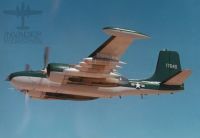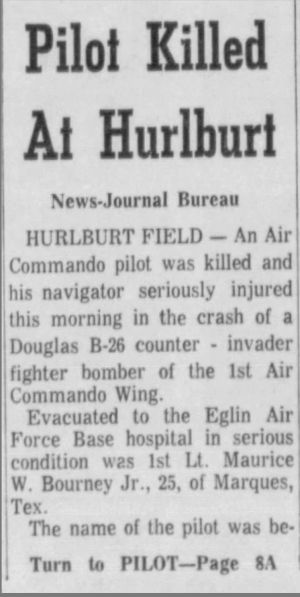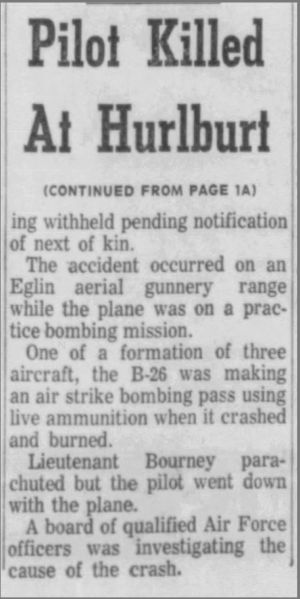64-17656
| B-26K-1 Invader | |||
|---|---|---|---|
| Builders: Douglas Aircraft Company On Mark Engineering | |||
| Operators: United States Air Force | |||
| Number Built: 40 | |||
| First Built: Jan 1963 (YB-26K) First test flight | |||
| GENERAL CHARACTERISTICS | |||
| Type: Light Attack Bomber | |||
| Weight: 25,130 lbs empty 37,000 lbs loaded | |||
| Length: 51' 7 3/16" (inc. guns) | |||
| Height: 19' 0" | |||
| Wingspan: 71'6" (including wingtip tanks) | |||
| Wing Area: 540 Sq. Feet (50.17 m²) | |||
| Speed: 169 mph (cruising) | |||
| Max Speed: 323 mph | |||
| Ceiling: 28,600' | |||
| Powerplant: Pratt & Whitney R-2800-103W | |||
| Horsepower: 2,500 | |||
| Fuel Capacity: 1,600 US Gallons | |||
| Range: 700 miles w/3518 lbs payload 1,480 miles empty | |||
| Crew: 2 | |||
| Passengers: 1 | |||
| ARMAMENT | |||
| Nose Guns: 8x .50 caliber guns | |||
| Dorsal Turret: None | |||
| Ventral Turret: None | |||
| Payload: 8,000 lbs on wings 4,000 lbs internal | |||
| Donate | |||
| Even a small donation of a couple of dollars goes a long way in helping | |||
See also: List of Invaders by Serial Number, Serial Numbers starting with 64
Converted from 44-35847.
This Counter Invader has the distinction of having the shortest service life of all of the B-26Ks. It was destroyed in a crash just 42 days after being accepted into service. In fact, it was destroyed before all of the B-26Ks had even fully entered service.
Operational History
10 Nov 1964 - Accepted into USAF Inventory from OnMark at Van Nuys, CA. [1]
11 Nov 1964 - Assigned to 1st Air Commando Wing at Hurlburt Field. [1]
16 Dec 1964 - 1st Air Commando Wing at Hurlburt Field [1]
22 Dec 1964 - Dropped from USAF Inventory due to accident. [1]. Written off at Eglin Range after crashing during low-level applied tactics mission. Pilot killed, navigator bailed but lost leg while exiting the aircraft. [2]
This was the 1st B-26K model lost and it had the shortest service life of any B-26K, with an operational period on the books of just 42 days.
The plane took off during the morning of Wednesday, 16 Dec as part of a flight of 3 planes. [3]. It was flying a bombing run exercise where it was equipped with live ammunition. [4] [5][6][3] Cpt. White died in the crash, but 1LT Bourney was able to parachute clear of the plane but suffered serious injuries and was hospitalized. [6][7][3]
Originally I had not been able to find any information on the crew listed in the accidents. Because the plane was not lost during war these airmen don't show up on memorial sites. Thanks to an anonymous donor who sent money to our PayPal account I was able to buy a premium Newspapers subscription and found 3 different articles that mention this crash, and the names of the crew, which I have updated below.
Subsequent to my posting the crew information, Dave Cantin of the CAF sent me a link to a 2010 Interview with Mr. Bourne himself. (https://www.vimeo.com/11069761). According to Mr. Bourne, the plane was flying over Bombing Range 65 at Eglin and was practicing low-level napalm and bombing runs. They were having some electrical issues in their plane. As they came in for another pass something didn't feel right to Mr. Bourne and he was about to flip the "Master Arm" switch to off to abort the run, but he wasn't able to act in time. The plane was travelling at around 300 mph and 30 or 40 feet above the ground. As the bombs fell out of the bomb bay they exploded essentially under the plane, sending pieces of shrapnel all through the wing, cockpit, and fuselage. Mr. Bourne checked the bomb bay compartment and could see that they were on fire. Cpt. White began to climb so that they had enough time to bail out. At about 400 feet above the ground the fire reached the cockpit and exploded the 100 gallon bomb bay tank that sat in the back of the cockpit and engulfed the cockpit in flames. Bourne and Cpt. White both reached up and pulled the emergency ejection handle that jettisoned their canopies so that they could bail out. They looked at each other and Maurice grabbed the window and rolled to the right, falling out of the plane, being swept over the wing and under the tail. At some point after bailing out he was either hit with debris, or snagged his leg on debris, but he lost his right leg at the knee. After he landed he waited in the swamp for about an hour until the helicopter from Eglin found him and returned him to base. Cpt. White did not survive. According to Maurice, he believes that Cpt. White waited until after Maurice had cleared the plane before he attempted to bail out and that this delay to ensure the safety of his navigator cost the pilot his life. [4]
Accidents
16 Dec 1964 - Crashed during low-level tactics exercise. Aircraft destroyed. [1][2]
Crew
Cpt. Thomas Ray White (KIA)
1LT. Maurice W. Bourne
Disposition
Lost in Accident Dec 1964.
Images
Sources
Databases searched:
- AAIR -
- MACR -
- KORWALD -
- Baugher
- ↑ 1.0 1.1 1.2 1.3 1.4 "Aerospace Vehicle Report, Oct-Dec 1964" Reel AVH-2, Pg 599 USAFHRA
- ↑ 2.0 2.1 http://www.joebaugher.com/usaf_serials/1964.html
- ↑ 3.0 3.1 3.2 The Pensacola News (Pensacola, Florida) · 16 Dec 1964, Wed · Page 8
- ↑ 4.0 4.1 Maurice Bourne B-26B and B-26K Navigator. Vimeo.com/11069761
- ↑ The Montgomery Advertiser (Montgomery, Alabama) · 18 Dec 1964, Fri · Page 27"
- ↑ 6.0 6.1 The Tampa Tribune (Tampa, Florida) · 18 Dec 1964, Fri · Page 4
- ↑ The Pensacola News (Pensacola, Florida) · 16 Dec 1964, Wed · Page 1






